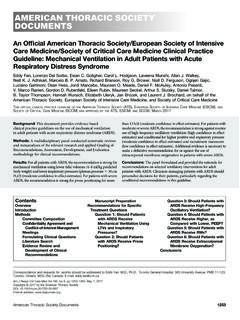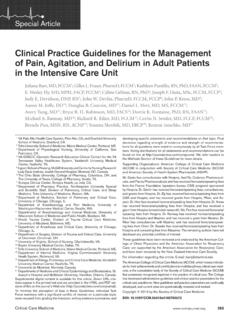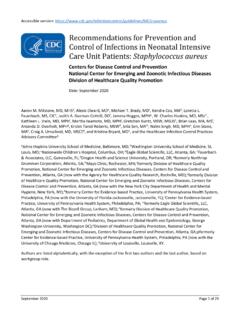Transcription of American Society of Addiction Medicine (ASAM) The ASAM ...
1 American Society of Addiction Medicine (ASAM). The ASAM Assessment for Treatment Planning and Placement in Service Why an Agency May Choose to Utilize This Tool Acknowledgement This project is supported by the Centers for Medicare and Medicaid Services (CMS) of the Department of Health and Human Services (HHS) as part of a financial assistance award totaling $2,530, with 100 percent funded by CMS/HHS. The contents are those of the author(s) and do not necessarily represent the official views of, nor an endorsement, by CMS/HHS, or the Government What is the ASAM Assessment? It is a clinical guide designed by the American Society of Addiction Medicine (ASAM) to improve assessment and outcomes-driven treatment and recovery services. It is used to match patients to appropriate types and levels of care There are separate assessments and criteria for placement and continued care for adolescents and adults It is used by Medicaid for prior authorization into residential and inpatient care , and for practitioners to determine what level of care is the right fit for the patient at varying intervals in their treatment.
2 It is multi-dimensional and assists practitioners in making objective decisions regarding patient admission, continuing care , and transfer/discharge for varying levels of care The Six Dimensions 1. Acute intoxication and/or withdrawal potential: Exploring an individual's past and current experiences of substance use and withdrawal Are there risks with the individual's current level of intoxication or withdrawal? Is there a history of severe withdrawal symptoms? Are services needed to address current intoxication or withdrawal? What level of service is safe: ambulatory or inpatient? 2. Biomedical conditions and complications: Exploring an individual's health history and current physical condition Are there current physical illnesses that need care ? Are chronic illnesses or conditions in need of stabilization?
3 3. Emotional, behavioral, or cognitive conditions and complications: Exploring an individual's thoughts, emotions, and mental health issues including a risk assessment Are there current psychological, behavioral, emotional, or cognitive issues that need to be addressed? Are there chronic BH conditions that need stabilization? Are symptoms related to Addiction or BH condition? 4. Readiness to change: Exploring an individual's readiness and interest in changing How aware is the individual of the relationship between substance use or other destructive behaviors? What is their readiness to change in all areas, , mental health, physical health, employment, 5. Relapse, continued use, or continued problem potential: Assesses the need for relapse prevention services What is the individuals understanding of triggers and coping skills to manage relapse?
4 Is the individual in immediate danger? 6. Recovery/living environment: Assesses the need for individualized family or significant other support and services Housing, financial, vocation, education, legal, transportation, or childcare services Do any family members, living situations, work, or school threaten the individual's safety or engagement in treatment? The Six Dimensions: Continued Determination of Risk Risk is: 1. Multidimensional and biopsychosocial 2. Relates to patient's history 3. Is expressed in current status, answering the question, how acute unstable, and active is the patient's current clinical presentation? . 4. Involves a degree of change from baseline or premorbid functioning Three components of imminent danger: 1. A strong probability that certain behaviors (such as continued alcohol, other drug use or addictive behavior relapse) will occur 2.
5 The likelihood that such behaviors will present a significant risk of serious adverse consequences to the individual and/or others 3. The likelihood that such adverse events will occur in the very near future, within hours and days, rather than weeks or months Imminent Danger 3 components of Imminent danger: 1) A strong probability that certain behaviors will occur ( continued use or relapse);. 2) The likelihood that such behaviors will present a significant risk of serious adverse consequences to the individual and/or others ;. 3) The likelihood that such adverse events will occur in the very near future, within hours and days, rather than weeks or months . Imminent danger in an OP or residential level of care : If an individual has problems in dimensions 4 & 5 that require 24-hour supervision and treatment interventions (such as boundary setting) the patient needs placement in a residential program that offers clinical staff and services 24 in order to respond to imminent danger.
6 Imminent danger in IP setting: If there is significant severity in dimensions 1, 2, and/or 3, her or his imminent danger will usually require services in an IP setting rather than a residential level. High probability of significant risk in the near future in any of the 6 dimensions. Dimensions 1, 2, or 3 requires medical and/or nursing interventions, and 4, 5, or 6 need clinical rather than medical and/or nursing interventions. ASAM Levels of care Level Early Intervention At risk of developing substance-related problems or when there is not yet sufficient information to document a diagnosable SUD prevention or risk aversion brief intervention services. Level 1 Outpatient Services Organized services in regularly scheduled sessions which may include medication management, counseling and psychosocial therapies; particularly effective with co-occurring conditions.
7 Can include ambulatory withdrawal management. Level 2 intensive Outpatient or Partial Hospitalization Services Can address multiple co-occurring issues with individualized service plans, and measurable treatment goals with specific strategies developed with the individual. Level 3 Residential/Inpatient Services Are co-occurring capable staffed by Addiction treatment, mental health, and general medical personnel who provide a range of services in a 24-hour treatment center. There are 5 sub-levels of care dependent on stabilization criteria and recovery skills. Level 4 Medically Managed intensive Inpatient Services 24 hour medically directed evaluation, care , and treatment of substance-related and co-occurring conditions in a hospital setting. Can include withdrawal management. Who can administer the ASAM assessment?
8 A credentialed counselor or clinician, a certified Addiction registered nurse, a psychologist, or a physician may gather diagnostic and multidimensional assessment data, however interpretation must be within the assessor's scope of practice. A certified peer support worker that has received ASAM assessment specific training may gather the information but must discuss findings with his/her supervisor or one of the above-named clinicians. Transfer to inpatient care , or referrals to residential or outpatient services must be made by a physician or independent practitioner. They are based on assessment criteria. Medicaid Policy and Reimbursement The ASAM assessment is done in addition to other BH assessments or diagnostic evaluations It does not render a diagnosis All six dimensions must be explored for a comprehensive SUD assessment in order to determine service needs and appropriate placement within the levels of care .
9 The assessment is coupled with a risk/severity rating as well as a needs profile. For less severe instances of substance use, appropriate screening may suffice. For Medicaid reimbursement: Reimbursement amounts are current, but subject to change HCPCS code H0002, currently reimbursed at $ FQHCs reimbursed at your encounter rate IHS and Tribal 638s reimbursed at the OMB rate Resources For comprehensive information: THE ASAM CRITERIA Treatment Criteria for Addictive, Substance-Related, and Co-Occurring Conditions, American Society of Addiction Medicine , Third Edition, 2013. For Medicaid policy and billing information, see the Behavioral Health Policy and Billing Manual Full Adult ASAM assessment Sample Adolescent ASAM assessment




